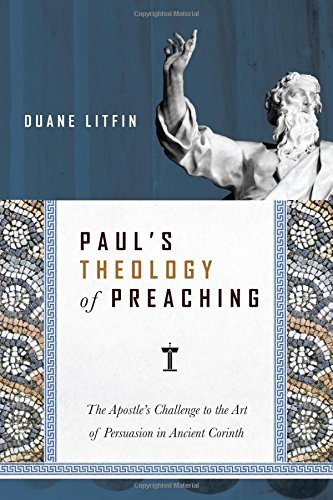Paul’s Theology of Preaching: The Apostle’s Challenge to the Art of Persuasion in Ancient Corinth, by Duane Litfin (IVP Academic, 2015), 400 pages.
Reviewed by Peter Moore
Duane Litfin’s Paul’s Theology of Preaching: The Apostle’s Challenge to the Art of Persuasion in Ancient Corinth updates and expands St. Paul’s Theology of Proclamation (1994), a revision of his dissertation. This latest version, which Litfin calls the “final” one, the one “envisioned from the outset” (12), represents decades of contemplation on this crucial subject through doctoral programs in rhetorical theory and New Testament and years of pastoral ministry.
While leaving out some of the documentation of the earlier version, this revision offers the reader interaction with more recent scholarship and further analysis and application of Paul’s theology for preaching today (26, 30). The text is reformatted so that the central argument is distinguished by larger font from thirty-three more technical excurses.
Summary
Litfin begins by contending that “every theory of discourse is anchored in the soil of its author’s presuppositions” and on this basis, that 1 Corinthians 1-4 is paramount for understanding Paul’s theology of preaching: nowhere else in his writings does he engage in such sustained reflection on the theological presuppositions underlying his preaching (41). Litfin’s estimation of these chapters rests on his view that in them Paul is primarily engaged in defending the form of his gospel proclamation against the Corinthians’ criticisms and that these criticisms spring from the Corinthians’ devotion to Greco-Roman rhetoric (137-160). In its three parts, Litfin’s book defends and expounds this interpretation.
Part one lays the foundation with a crisp overview of the art of rhetoric in the ancient world: its “beginnings,” “goal,” “power,” “reach,” “genius,” “appraisal,” “hazards,” “rewards,” and “grand equation” (chapters 1-9). Litfin uncovers the essential features of the art of persuasion, avoiding common reductions of rhetoric to unscrupulous manipulation, mere ornamentation, or endless classification of figures of speech; and he shows its prominent role in Greco-Roman society. This overview serves to commend the rhetorical tradition as the appropriate source of the criticism of Paul addressed 1 Corinthians 1-4 (a view common in the history of interpretation and now much revived, but out of favor at the time that Litfin wrote his dissertation) and to equip the reader to conceive properly Paul’s contrasts between his preaching and the wisdom of the world.
Part two turns to the text itself, focusing on 1 Corinthians 1:17-2:5. Litfin notes that “the verbs Paul uses to describe his public speaking…are decidedly non-rhetorical” (184), and he finds especially telling Paul’s use of terms associated with the ancient herald. “Unlike the orator, the herald’s task was not to create a powerful message custom designed to generate belief (πίστις) or persuasion (πεισομονὴ) in the recipients. The herald’s task was to convey as faithfully as possible the already constituted message of another” (185).
What is critical to grasp is that Paul views this heraldic form of the message to be an outworking of its content. The straightforward proclamation of the gospel accords with God’s nullifying human pride in the cross of Christ and the calling of the Corinthians, because it grounds the hearer’s faith in the Spirit’s work rather than human wisdom and eloquence. The form of gospel proclamation and the content of the gospel thus stand together, and, in fact, Litfin argues, the two are encapsulated in Paul’s use of κήρυγμα in 1:21 (195-213).
Part three summarizes and analyzes the “ministry model” that emerges from these chapters, setting in greater relief the contrasting “stances” of the orator and the preacher. The orator is tasked and, given the proper training and gifts, empowered to move the audience to yield to his message. The preacher is called to make known faithfully the message, leaving the hearer’s response to the Spirit. For the orator, the results are determined and the message is variable. For the preacher, the message is determined and the results are variable. The orator is judged by whether he has been persuasive; the preacher is judged by whether he has been obedient (270-271, 280).
In chapters 17 and 18, Litfin addresses most fully an issue raised repeatedly in the book: the relationship between Paul’s disavowals of rhetoric and the apparent presence of rhetoric in his letters and in the account of his sermons in Acts. Litfin’s engagement with this complicated question reveals the subtlety and boldness of his thesis. While allowing that Paul has rhetorical intention, broadly conceived, (that is, he aims to influence, 286-287, 293), employs communicative features discussed by rhetoricians (293), and adapts his message to facilitate the audience’s comprehension (276-277, 283-284), Litfin rejects the solution that Paul, in 1 Corinthians 1-4, merely opposes the “bad” rhetoric of the sophists, leaving untouched the good rhetoric of the philosophers (150-153, 260, 274, 294-297). He insists on the more radical position that Paul’s critique cuts to the heart of ancient rhetoric, even in its best forms, and he seeks to exonerate Paul from knowingly or unknowingly violating his theory in his practice.
In the final chapters (19 and 20) Litfin applies Paul’s ministry model to contemporary preaching and ministry. While more in depth discussion would be welcome here, his comments orient the reader to the appropriate aims and posture of the preacher in light of his study. Five short appendices discuss his interpretation with relation to Apollos, the book of Acts, and Paul’s epistemology and further draw out implications for preaching and ministry.
Evaluation
Though Litfin’s study is in many ways thorough, a few areas would benefit from further analysis, especially with regard to the relationship between Paul’s theory and practice. For instance, how does Paul’s emotive language relate to a disavowal of the human dynamics of persuasion? Likewise, how does the necessity of the simple heralding of the message square with the discursive nature of Paul’s communication to unbelievers in Acts (e.g., Acts 17:22-31; 19:8)? Litfin’s survey of these speeches (288, 308-309, 327-333) and his discussions of epistemology (179-181, 208-209, 334-338) are suggestive, but more detailed treatment would help clarify Paul’s theology and inform contemporary questions over the legitimacy of apologetic argumentation in evangelism.
While Litfin’s study of Paul’s theology of preaching emphasizes Paul’s role as a herald, a complete account of that theology would require more consideration of other passages and descriptions of his preaching and of his ministry in general. “Herald” sets in the foreground stewardship and accountability to God; other characterizations, for instance, better capture Paul’s earnest desire for his hearers to be saved and made holy, a desire which also plays a role in shaping the form of his communication to believers and unbelievers.
This final point is more a clarification than criticism of Litfin’s work: it is not foremost a survey of the relevant passages of Paul’s preaching and ministry throughout his letters or even in the Corinthian correspondence (though it touches on many of these), but rather a detailed examination of Paul’s most sustained reflection on his proclamation at the beginning of 1 Corinthians. As such, it powerfully confronts the reader with Paul’s understanding of the counterintuitive and countercultural form of his gospel proclamation, which alone accords with his gospel message. This is an outstanding book, worthy to be wrestled with and applied.
Peter Moore is a PhD student in Hermeneutics and Biblical Interpretation at Westminster Theological Seminary.
Preview or buy it here on Amazon.



